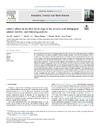Identificador persistente para citar o vincular este elemento:
https://accedacris.ulpgc.es/jspui/handle/10553/74509
| Título: | Salinity effects on the first larval stage of the invasive crab Hemigrapsus takanoi: Survival and swimming patterns | Autores/as: | Landeira Sánchez, José María Liu, Baobo Omura, Takuo Akiba, Tatsuro Tanaka, Yuji |
Clasificación UNESCO: | 2401 Biología animal (zoología) 251005 Zoología marina |
Palabras clave: | Behavior Dispersal Invasive Species Salinity Zoea |
Fecha de publicación: | 2020 | Publicación seriada: | Estuarine, Coastal and Shelf Science | Resumen: | The Asian brush-clawed shore crab Hemigrapsus takanoi has high tolerance for environmental changes facilitated the establishment of non-native populations along the Atlantic European coast. The self-maintenance and potential spread of this invasive crab will partially depend on its ability to disperse during the larval period. Larvae are not equipped with efficient osmoregulatory mechanisms to tolerate low salinity conditions; therefore, they evolved specific swimming behavior that facilitates exportation offshore for development in more stable and higher salinity conditions. To study the salinity tolerance, we quantified the survival of newly hatched larvae subjected to salinities ranging from 2 to 35 over a 24 h period. We observed that more than 50% of larvae could survive 24 h only at salinities higher than 20, and that shorter incubation periods of 2–6 h could produce high mortality at salinities lower than 10. We used video-tracking techniques to quantify swimming in newly hatched larvae at different levels of salinity, and under starvation or food availability conditions. The results showed that apparent swimming speed increases as salinity increases, and that upward trajectories are faster than downward ones. When food was available, the larvae reduced the frequency of helical swimming trajectories, turned out to be faster, straighter and more vertical. At salinities lower than 20, the swimming trajectories became more random, and the described patterns tended to disappear. Our results indicate that lower survival and reduced swimming performance may constrain the dispersal capacity of the non-native populations located at low salinity habitats. | URI: | https://accedacris.ulpgc.es/handle/10553/74509 | ISSN: | 0272-7714 | DOI: | 10.1016/j.ecss.2020.106976 | Fuente: | Estuarine, Coastal and Shelf Science [ISSN 0272-7714], v. 245, 106976, (Octubre 2020) |
| Colección: | Artículos |
Citas SCOPUSTM
5
actualizado el 08-jun-2025
Citas de WEB OF SCIENCETM
Citations
4
actualizado el 08-jun-2025
Visitas
110
actualizado el 12-oct-2024
Descargas
307
actualizado el 12-oct-2024
Google ScholarTM
Verifica
Altmetric
Comparte
Exporta metadatos
Los elementos en ULPGC accedaCRIS están protegidos por derechos de autor con todos los derechos reservados, a menos que se indique lo contrario.
